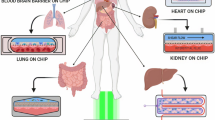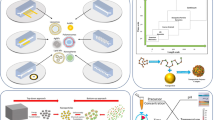Abstract
Laminar and pulsatile flow of aqueous solutions in microfluidic channels can be useful for controlled delivery of cells and molecules. Dispersion effects resulting from diffusion and convective disturbances, however, result in reagent delivery profiles becoming blurred over the length of the channels. This issue is addressed partially by using oil-in-water phase systems. However, there are limitations in terms of the biocompatibility of these systems for adherent cell culture. Here we present a fully biocompatible aqueous two-phase flow system that can be used to pattern cells within simple microfluidic channel designs, as well as to deliver biochemical treatments to cells according to discrete boundaries. We demonstrate that aqueous two-phase systems are capable of precisely delivering cells as laminar patterns, or as islands by way of forced droplet formation. We also demonstrate that these systems can be used to precisely control chemical delivery to preformed monolayers of cells growing within channels. Treatments containing trypsin were localized more reliably using aqueous two-phase delivery than using conventional delivery in aqueous medium.





Similar content being viewed by others
References
P.A. Albertsson, Partition of Cell Particles and Macromolecules (Wiley, New York, 1972)
E. Berthier, J. Warrick, et al., Pipette-friendly laminar flow patterning for cell-based assays. Lab Chip. (2011)
A.M. Bilek, K.C. Dee et al., Mechanisms of surface-tension-induced epithelial cell damage in a model of pulmonary airway reopening. J. Appl. Physiol. 94(2), 770–783 (2003)
A. Bransky, N. Korin et al., Experimental and theoretical study of selective protein deposition using focused micro laminar flows. Biomed. Microdevices 10(3), 421–428 (2008)
E. Brouzes, M. Medkova et al., Droplet microfluidic technology for single-cell high-throughput screening. Proc. Natl. Acad. Sci. U.S.A. 106(34), 14195–14200 (2009)
N. Futai, W. Gu, S. Takayama, Rapid prototyping of microstructures with bell-shaped cross-sections and its application to deformation-based microfluidic valves. Adv. Mater. 15, 1320–1323 (2004)
A. George, F. Truskey, Y. David, F. Katz, Transport Phenomena in Biological Systems, (Prentice Hall, 2008)
W. Gu, X. Zhu et al., Computerized microfluidic cell culture using elastomeric channels and Braille displays. Proc. Natl. Acad. Sci. U.S.A. 101(45), 15861–15866 (2004)
P. Guillot, A. Colin, Stability of parallel flows in a microchannel after a T junction. Phys. Rev. E Stat. Nonlin. Soft Matter Phys. 72(6 Pt 2), 066301 (2005)
T. Hahn, S. Hardt, Size-dependent detachment of DNA molecules from liquid–liquid interfaces. Soft Matter, epub ahead of print (2011)
T. Hahn, G. Munchow et al., Electrophoretic transport of biomolecules across liquid-liquid interfaces. J. Phys. Condens. Matter 23(18), 184107 (2011b)
A. Jovic, B. Howell et al., Phase-locked signals elucidate circuit architecture of an oscillatory pathway. PLoS Comput. Biol. 6(12), e1001040 (2010)
D. Lai, J.P. Frampton, et al, Rounded Microchannels with Constrictions Made in One Step by Backside Diffused Light Lithography Enables Aqueous Two-Phase System Droplet Microfluidics. In Submission. (2011)
W. Liu, L. Li et al., An integrated microfluidic system for studying cell-microenvironmental interactions versatilely and dynamically. Lab Chip 10(13), 1717–1724 (2010)
E.M. Lucchetta, J.H. Lee et al., Dynamics of Drosophila embryonic patterning network perturbed in space and time using microfluidics. Nature 434(7037), 1134–1138 (2005)
J.C. McDonald, D.C. Duffy et al., Fabrication of microfluidic systems in poly(dimethylsiloxane). Electrophoresis 21(1), 27–40 (2000)
K.H. Nam, W.J. Chang et al., Continuous-flow fractionation of animal cells in microfluidic device using aqueous two-phase extraction. Biomed. Microdevices 7(3), 189–195 (2005)
F.Q. Nie, M. Yamada et al., On-chip cell migration assay using microfluidic channels. Biomaterials 28(27), 4017–4022 (2007)
J. Olofsson, H. Bridle et al., Direct access and control of the intracellular solution environment in single cells. Anal. Chem. 81(5), 1810–1818 (2009)
B. Regenberg, U. Kruhne et al., Use of laminar flow patterning for miniaturised biochemical assays. Lab Chip 4(6), 654–657 (2004)
A. Sawano, S. Takayama et al., Lateral propagation of EGF signaling after local stimulation is dependent on receptor density. Dev. Cell 3(2), 245–257 (2002)
J.R. Soohoo, G.M. Walker, Microfluidic aqueous two phase system for leukocyte concentration from whole blood. Biomed. Microdevices 11(2), 323–329 (2009)
S. Takayama, J.C. McDonald et al., Patterning cells and their environments using multiple laminar fluid flows in capillary networks. Proc. Natl. Acad. Sci. U.S.A. 96(10), 5545–5548 (1999)
S. Takayama, E. Ostuni et al., Selective chemical treatment of cellular microdomains using multiple laminar streams. Chem. Biol. 10(2), 123–130 (2003)
H. Tavana, A. Jovic et al., Nanolitre liquid patterning in aqueous environments for spatially defined reagent delivery to mammalian cells. Nat. Mater. 8(9), 736–741 (2009)
S.Y. Teh, R. Lin et al., Droplet microfluidics. Lab Chip 8(2), 198–220 (2008)
Y.S. Torisawa, B. Mosadegh et al., Microfluidic platform for chemotaxis in gradients formed by CXCL12 source-sink cells. Integr. Biol. (Camb.) 2(11–12), 680–686 (2010)
M. Tsukamoto, S. Taira et al., Cell separation by an aqueous two-phase system in a microfluidic device. Analyst 134(10), 1994–1998 (2009)
A.D. van der Meer, K. Vermeul et al., A microfluidic wound-healing assay for quantifying endothelial cell migration. Am. J. Physiol. Heart Circ. Physiol. 298(2), H719–H725 (2010)
K. Vijayakumar, S. Gulati, A.J. de Mello, J.B. Edel, Rapid cell extraction in aqueous two-phase microdroplet systems. Chem. Sci. 1, 447–452 (2010)
L.G. Villa-Diaz, Y.S. Torisawa et al., Microfluidic culture of single human embryonic stem cell colonies. Lab Chip 9(12), 1749–1755 (2009)
S.T. Wei-Heong Tan, Monodisperse alginate hydrogel microbeads for cell encapsulation. Adv. Mater 19, 2696–2701 (2007)
M.H. Wu, S.B. Huang et al., Microfluidic cell culture systems for drug research. Lab Chip 10(8), 939–956 (2010)
M. Yamada, V. Kasim et al., Continuous cell partitioning using an aqueous two-phase flow system in microfluidic devices. Biotechnol. Bioeng. 88(4), 489–494 (2004)
E.W. Young, D.J. Beebe, Fundamentals of microfluidic cell culture in controlled microenvironments. Chem. Soc. Rev. 39(3), 1036–1048 (2010)
B. Zheng, J.D. Tice, R.F. Ismagilov, Formation of arrayed droplets by soft lithography and two-phase fluid flow and application in protein crystallization. Adv. Mater. 16(15), 1365–1368 (2004)
I. Ziemecka, V. van Steijn et al., Monodisperse hydrogel microspheres by forced droplet formation in aqueous two-phase systems. Lab Chip 11(4), 620–624 (2011)
Acknowledgements
The authors would like to thank Dr. Tommaso Bersano-Begey for designing the Braille computer interface. The authors would also like to thank NSF (CMMI 0700232 and DBI 0852802) and MEST NRF (WCU-R322008000200540) for funding as well as NIH (TEAM Tissue Engineering and Regeneration Training Grant NIDCR DE007057) for a postdoctoral fellowship to JPF.
Author information
Authors and Affiliations
Corresponding author
Rights and permissions
About this article
Cite this article
Frampton, J.P., Lai, D., Sriram, H. et al. Precisely targeted delivery of cells and biomolecules within microchannels using aqueous two-phase systems. Biomed Microdevices 13, 1043–1051 (2011). https://doi.org/10.1007/s10544-011-9574-y
Published:
Issue Date:
DOI: https://doi.org/10.1007/s10544-011-9574-y




